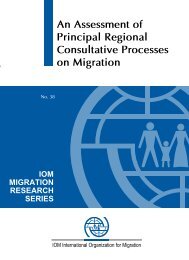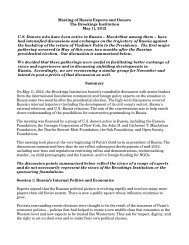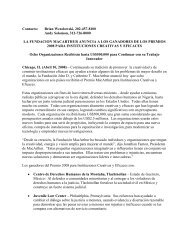A Global Compact on Learning - Brookings Institution
A Global Compact on Learning - Brookings Institution
A Global Compact on Learning - Brookings Institution
You also want an ePaper? Increase the reach of your titles
YUMPU automatically turns print PDFs into web optimized ePapers that Google loves.
West Asia and Sub-Saharan Africa. Only 36 percent<br />
of girls enroll in lower sec<strong>on</strong>dary school in Sub-<br />
Saharan Africa, and the gender gap in sec<strong>on</strong>dary<br />
enrollment has actually grown wider since 2000. 163<br />
Even more than gender, poverty and rural residence<br />
are str<strong>on</strong>gly associated with low enrollment<br />
in sec<strong>on</strong>dary school. 164 Issues of equity play a particularly<br />
important role when it comes to sec<strong>on</strong>dary<br />
educati<strong>on</strong> because it is increasingly the key determinant<br />
of subsequent life chances. Participati<strong>on</strong> in<br />
sec<strong>on</strong>dary educati<strong>on</strong>, however, tends to be regressive<br />
with income thereby reinforcing disparities. 165<br />
In Sub-Saharan Africa, children from the richest 20<br />
percent of households have <strong>on</strong> average more than<br />
eleven times the chance of reaching grade 9 than<br />
those from the poorest 40 percent. 166<br />
Although access helps children get through the<br />
door, it does not guarantee good learning outcomes.<br />
Therefore, any approach to improving learning<br />
must address barriers that prevent girls and boys<br />
from c<strong>on</strong>tinuing their educati<strong>on</strong> as well as targeted<br />
measures to improve the quality of the teaching and<br />
learning process. Many of the approaches discussed<br />
below are not new but either have not been prioritized,<br />
appropriately implemented and resourced,<br />
or taken to scale. Although individual barriers are<br />
discussed separately below, a holistic approach of<br />
addressing multiple barriers has been found to be<br />
most effective in increasing enrollment, attendance,<br />
and achievement in sec<strong>on</strong>dary school. 167<br />
Generating the financial resources required to expand<br />
sec<strong>on</strong>dary and post-primary educati<strong>on</strong>al opportunities<br />
is a major challenge facing most developing<br />
countries. In low-enrollment countries, the<br />
per-student unit cost of post-primary learning is significantly<br />
more expensive than at the primary level. 168<br />
Expanding post-primary educati<strong>on</strong> also requires<br />
achieving cost-efficiencies in deploying and utilizing<br />
existing resources, such as through prioritizing measures<br />
discussed here. In some cases, student/teacher<br />
ratios and teaching time can be increased where they<br />
are low. 169 Additi<strong>on</strong>ally, expanding post-primary educati<strong>on</strong><br />
requires mobilizing increased resources and<br />
working with n<strong>on</strong>governmental partners, including<br />
the private sector, n<strong>on</strong>governmental organizati<strong>on</strong>s<br />
(NGOs), and civil society groups. This approach includes<br />
various forms of public–private partnerships,<br />
which are particularly helpful to mobilize additi<strong>on</strong>al<br />
resources, provide professi<strong>on</strong>al support services, and<br />
stimulate creative and innovative thinking. 170 The<br />
state, while maintaining ultimate resp<strong>on</strong>sibility for<br />
the provisi<strong>on</strong> of basic educati<strong>on</strong> for all young people,<br />
frequently needs to partner with n<strong>on</strong>governmental<br />
actors to deliver high-quality post-primary learning<br />
opportunities.<br />
Five main acti<strong>on</strong>s need to be taken to achieve Strategy<br />
3A:<br />
• Provide well-targeted, appropriately structured<br />
subsidies for educati<strong>on</strong>ally marginalized<br />
groups.<br />
• Provide a safe envir<strong>on</strong>ment and girl-friendly<br />
school policies.<br />
• Cultivate community support and encouragement<br />
for <strong>on</strong>going learning for both girls<br />
and boys.<br />
• Offer sec<strong>on</strong>d-chance learning opportunities.<br />
• Provide flexible post-primary models utilizing<br />
innovative modes of delivery, including<br />
technology innovati<strong>on</strong>s, where appropriate.<br />
The first needed acti<strong>on</strong> is to provide well-targeted,<br />
appropriately structured subsidies for educati<strong>on</strong>ally<br />
marginalized groups. High direct and indirect costs<br />
are the principal reas<strong>on</strong> that children who complete<br />
primary school do not make the transiti<strong>on</strong> to sec<strong>on</strong>dary<br />
school. Therefore, lowering or eliminating<br />
financial barriers through well-targeted and structured<br />
scholarships, stipends, or other forms of subsidies<br />
has been shown to improve young people’s<br />
school enrollment and retenti<strong>on</strong> rates. Even in countries<br />
that include lower or junior sec<strong>on</strong>dary school<br />
as part of basic educati<strong>on</strong> (generally eight to ten<br />
years), households often have to pay school fees or<br />
other costs associated with going to school (see box<br />
4.2). In Sub-Saharan Africa, this household c<strong>on</strong>tributi<strong>on</strong><br />
amounts to 30 to 60 percent of the cost of<br />
sec<strong>on</strong>dary schooling. 171 As children grow older, the<br />
opportunity cost of attending school is even larger<br />
because there are increased pressures (and abilities)<br />
for young people to earn an income.<br />
A <str<strong>on</strong>g>Global</str<strong>on</strong>g> Compa c t <strong>on</strong> <strong>Learning</strong>: Taking Acti<strong>on</strong> <strong>on</strong> Educat i o n in Developing Countries<br />
C e n t e r for Universal Educat i o n at <strong>Brookings</strong><br />
33






